
Van Gogh Museum vs Rijksmuseum: Which Amsterdam Icon Should You Visit?
If you’re tight on time in Amsterdam and can only pick one museum, you’ll almost always end up choosing between two heavyweights: the Van Gogh Museum and the Rijksmuseum.
Here’s the short version: if you’re itching for a deep, personal look at one genius’s life, Van Gogh’s your guy. If you want to wander through centuries of Dutch creativity, the Rijksmuseum’s the place.
Both are stunning, but the experiences couldn’t be more different.
Honestly, I’ve lost count of how many times I’ve wandered through each, and the atmospheres just hit differently. The Van Gogh Museum feels almost like you’re sneaking into Vincent’s private world, watching his style shift and his mind race.
The Rijksmuseum? It’s a cathedral to Dutch history—massive, ornate, and packed with stories.
You could technically squeeze both into a day, but man, that’s a marathon. Know what you want from your museum visit before you even walk in the door. Trust me, it’ll save you from decision fatigue.
Table of Contents
- Key Takeaways
- Van Gogh Museum vs Rijksmuseum: Key Differences
- Overview of Each Museum
- Collection Focus and Artistic Scope
- Visitor Experience and Atmosphere
- Exploring the Rijksmuseum
- Dutch Golden Age Masterpieces
- Decorative Arts and Historical Artifacts
- Architectural Highlights and Cuypers Library
- Inside the Van Gogh Museum
- Vincent van Gogh’s Masterworks
- Chronological Journey Through Van Gogh’s Life
- Influences and Contemporaries
- Must-See Highlights at Each Museum
- Top Artworks at the Rijksmuseum
- Unmissable Pieces at the Van Gogh Museum
- Visitor Information and Practical Tips
- Museum Tickets and Booking Advice
- Best Times to Visit
- Duration and Accessibility
- Choosing the Right Museum for You
- Ideal Audience for Each Museum
- Combining Both Museums in One Day
- Nearby Attractions and Museumplein
- Frequently Asked Questions
- What are the key differences in the collections of the Van Gogh Museum and the Rijksmuseum?
- Can you suggest which museum would be more suitable for a visitor with limited time in Amsterdam?
- Are there any combination tickets available that include entry to both the Van Gogh Museum and the Rijksmuseum?
- What unique experiences does each museum offer that can’t be found in the other?
- Could you highlight the best times to visit the Van Gogh Museum and the Rijksmuseum to avoid crowds?
- What are the must-see exhibits for first-time visitors to both the Van Gogh Museum and the Rijksmuseum?
- Book Your Dream Experience
- More Travel Guides
Key Takeaways
- Van Gogh Museum zooms in on one artist’s journey
- Rijksmuseum sweeps across Dutch art and history
- Planning ahead is your best friend for seeing both
Van Gogh Museum vs Rijksmuseum: Key Differences
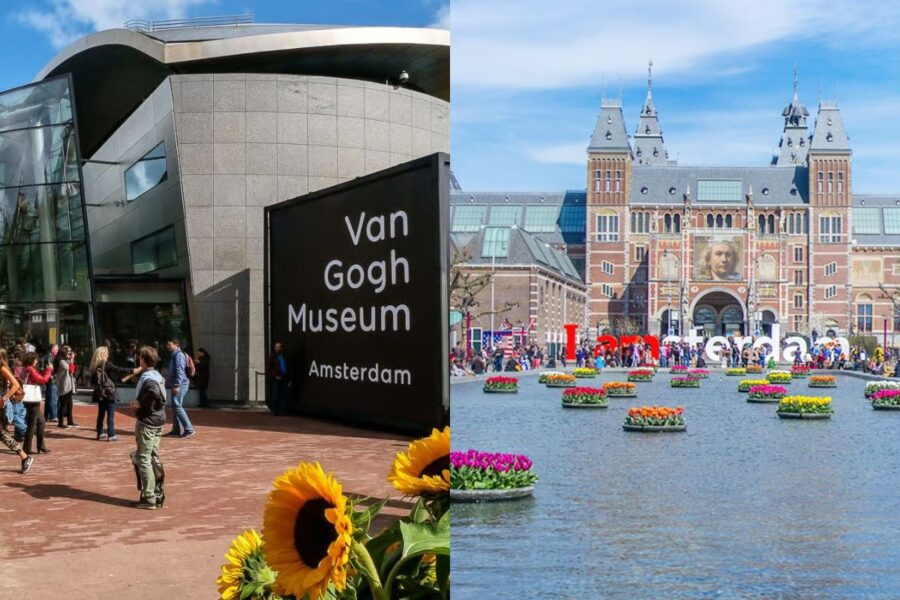
These two museums practically sit next door to each other on Museumplein, but the journeys they offer couldn’t be more different.
One pulls you into Van Gogh’s mind; the other launches you across centuries of Dutch stories and creativity.
Your pick really depends on whether you’re in the mood for intimacy or the full historical epic.
Overview of Each Museum
The Van Gogh Museum puts Vincent front and center. It’s not enormous, but it’s packed with layers—his moody early works, those wild color experiments, and even his letters and sketches. You’ll spot works by his friends and rivals too.
The Rijksmuseum stands as Amsterdam’s grand showcase of art and history. You’ll find over 8,000 objects inside, ranging from medieval altarpieces to sleek 20th-century design. The stars? Dutch Golden Age masterpieces—Rembrandt’s The Night Watch, Vermeer’s The Milkmaid, and a lot more.
If you’re short on time, Van Gogh is easier to tackle in one go. The Rijksmuseum can swallow you whole if you don’t map out your route.
Collection Focus and Artistic Scope
Van Gogh Museum’s collection is laser-focused but incredibly deep. It’s all about Vincent’s evolution—watching him play with color, light, and brushwork. You’ll notice his style morphs completely in Paris, Arles, and Saint-Rémy.
The Rijksmuseum casts a wide net. Paintings, sure, but also ship models, Delftware, furniture, and artifacts from every era. You’ll bump into Dutch masters like Frans Hals and Jan Steen, but also Asian art and a few surprises from modern times.
Here’s a quick snapshot:
| Museum | Artistic Periods | Key Highlights |
|---|---|---|
| Van Gogh Museum | Late 19th century, Post-Impressionism | Sunflowers, The Bedroom, personal letters |
| Rijksmuseum | 1200s–20th century, Dutch Golden Age focus | The Night Watch, The Milkmaid, Delftware |
Visitor Experience and Atmosphere
The Van Gogh Museum feels focused and even a bit cozy. You move through his life chronologically, almost like you’re shadowing him from room to room. It’s usually busy, but the scale keeps things manageable.
The Rijksmuseum is a beast—soaring ceilings, stained glass, echoing halls. The building itself is a work of art. You’ll need stamina and probably a coffee break halfway through.
Crowds gather around the big-name pieces in Van Gogh, while in the Rijksmuseum, you can duck into quieter galleries for a breather, even on a packed day.
If you prefer slow, thoughtful wandering, Van Gogh’s your spot. If you’re up for a bit of an adventure, the Rijksmuseum will keep you busy for hours.
Exploring the Rijksmuseum
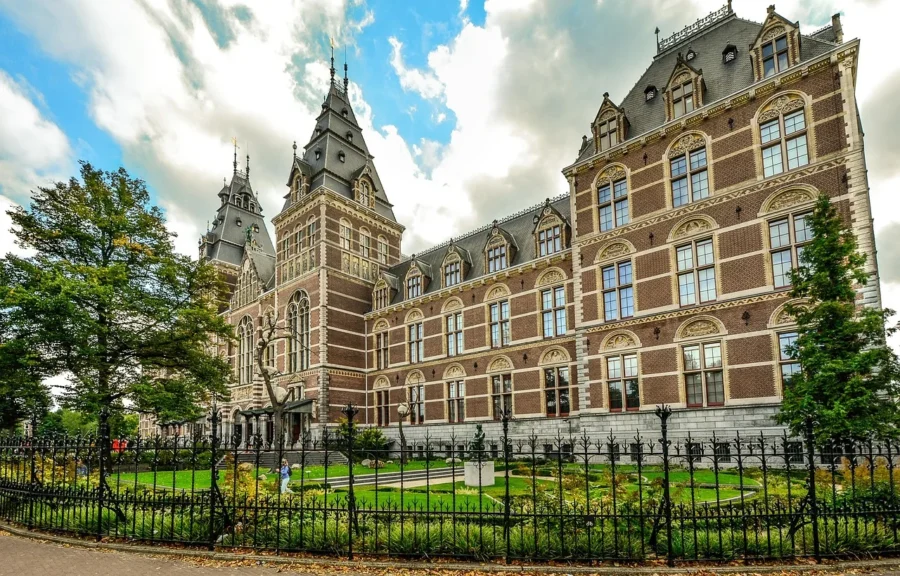
The Rijksmuseum? It’s like time travel through Dutch art and history, all under a single roof. You’ll see Rembrandt’s drama, Vermeer’s tranquil light, and rows of blue-and-white Delftware.
There’s even a library that looks straight out of a classic European novel.
It’s not just about paintings—the whole place tells the story of the Netherlands in objects, architecture, and atmosphere.
Dutch Golden Age Masterpieces
If you love the Dutch Golden Age, you’ll want to linger here.
Rembrandt’s The Night Watch dominates the room—a massive, moody canvas that always draws a crowd. I’ve watched people stand in awe, just soaking it in.
You’ll spot Vermeer’s The Milkmaid, glowing quietly in a corner, and Jan Steen’s lively scenes that almost make you hear the laughter and chaos. Frans Hals shows up too, with those loose, confident brushstrokes that seem almost reckless but never miss.
Take your time in these rooms—grab a bench, stare at the details, and watch how the light works its magic. There’s no rush.
Decorative Arts and Historical Artifacts
Beyond the paintings, the Rijksmuseum’s decorative arts are a hidden gem. You’ll find Delftware in every shape and size—tiles, plates, vases, you name it. Some pieces are so detailed, you’ll wonder how anyone painted them by hand.
Ship models, intricate silver, and furniture from centuries ago fill the rooms. I always get a kick out of the dollhouses, especially Petronella Oortman’s—tiny, perfect, and packed with history.
These artifacts tell stories you won’t get from paintings alone. They show daily life, tastes, and the sheer skill of Dutch artisans. It’s like opening a door to another era.
Architectural Highlights and Cuypers Library
The Rijksmuseum itself is a masterpiece. Pierre Cuypers designed it in the late 19th century, mixing Gothic and Renaissance touches—arched ceilings, painted walls, and stained glass that glows on a sunny day.
Definitely duck into the Cuypers Library. It’s the oldest art history library in the country, with shelves that seem to stretch forever. There’s a hush in there—you’ll catch yourself whispering without even meaning to.
Even if you’re not a library buff, it’s worth a look. Feels like you’ve stepped into a scene from an old European film—quiet, moody, and perfect for a photo.
Inside the Van Gogh Museum
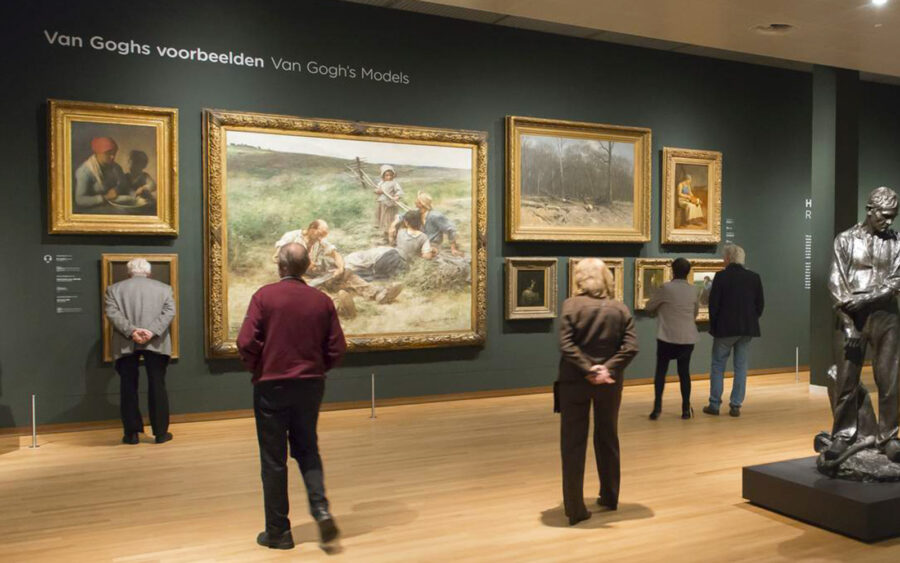
Step into the Van Gogh Museum, and you’ll feel like you’re flipping through Vincent’s personal diary—only in paint, not words.
The galleries lead you through Van Gogh’s brightest highs and darkest lows, plus the people and ideas that shaped him. Each floor has its own vibe, and it’s surprisingly easy to lose track of time.
Vincent van Gogh’s Masterworks
The big draw here? Those paintings you’ve seen a million times on mugs and posters—but now you get the real thing.
The Potato Eaters (1885) sits in a shadowy corner, all earthy browns and rough brushwork. It’s gritty, nothing like the sunbursts he painted later.
Turn another corner, and Sunflowers just blazes at you—those yellows jump off the canvas. You can’t help but stop and stare; the texture is wild.
Almond Blossom hangs nearby, delicate and light, painted as a gift for his nephew. It’s the soft side of Vincent you don’t always expect.
Seeing these up close is a whole different experience. The paint sits thick on the canvas, almost sculptural. You’ll want to lean in, but don’t get too close—museum guards have eagle eyes.
Chronological Journey Through Van Gogh’s Life
The museum arranges the collection so you walk through his life in order. You start in the Dutch years—dark, muted, working-class scenes.
Step by step, the colors shift. In Paris, he experiments with pastels and quick strokes. By Arles and Saint-Rémy, you’re surrounded by those wild blues and oranges, the swirling skies everyone knows.
It’s not just about the paintings. They display his letters to Theo right next to the art, so you get snippets of his thoughts. One minute you’re staring at The Bedroom, the next you’re reading how he sketched it out for his brother.
Influences and Contemporaries
Van Gogh didn’t paint in a bubble. The museum carves out space for artists who shaped him, and those he inspired.
You’ll see works by Paul Gauguin—their friendship was famously rocky—and pieces by Monet and other movers of modern art.
These side-by-side displays let you play detective. Japanese prints nudged him toward bold outlines, while French impressionists pushed him into brighter colors. Try to spot what he borrowed and what he reinvented.
Some galleries show artists who ran with his bold style after he died. It’s a reminder—his influence just keeps echoing.
Must-See Highlights at Each Museum
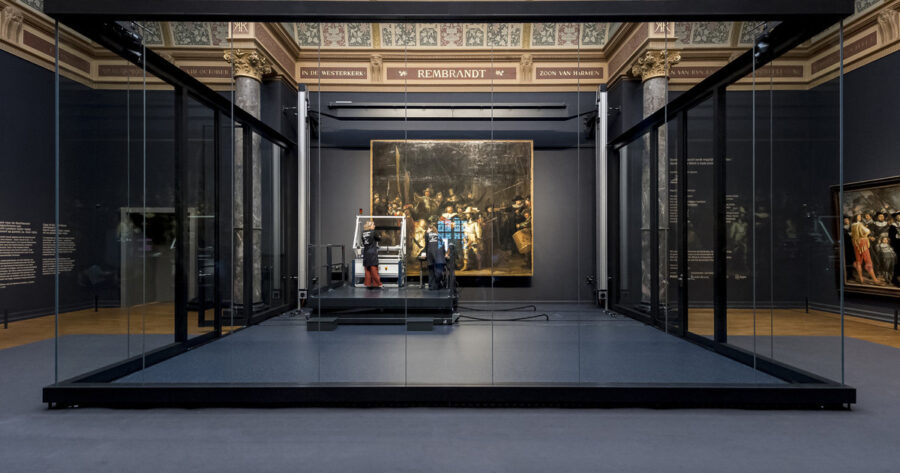
Pressed for time? It’s smart to know what’s worth running to first. Some pieces are famous for their backstory, others for sheer artistry, and a few just stop you in your tracks. Here’s what I’d make a beeline for.
Top Artworks at the Rijksmuseum
Start with Rembrandt’s The Night Watch. It’s enormous, full of drama, and honestly, it’s darker and more intense in real life. I’ve stood there imagining the figures stepping right out of the canvas.
Vermeer’s The Milkmaid is tiny but powerful. The light on the bread and milk is just… perfect.
If you’ve got a bit more time, swing by Jan Steen’s The Merry Family. It’s rowdy, a bit cheeky, and feels like you’ve crashed a 17th-century party.
You’ll notice Van Gogh’s self-portrait tucked away—it always throws people off, since they expect all his work to be next door. And if you’re into history, poke around the ship models, antique weapons, or even the WWII fighter plane hiding in the galleries.
Unmissable Pieces at the Van Gogh Museum
Here, it’s all about getting nose-to-canvas with Vincent’s brushwork.
The Potato Eaters is raw and smoky, a world away from his later colors. Stand there a minute—you’ll almost smell the oil lamp.
Sunflowers is pure energy. The thick paint and wild yellows make it hard to walk past.
Almond Blossom is gentle and hopeful, painted for his nephew. Even in a crowded room, it feels peaceful.
Don’t skip Self-Portrait with Felt Hat—the colors are wild, the texture almost jumps off the canvas. And The Bedroom? It’s a peek into his life in Arles, crooked lines and all. Feels strangely personal, like you’re seeing the world through his eyes.
Visitor Information and Practical Tips
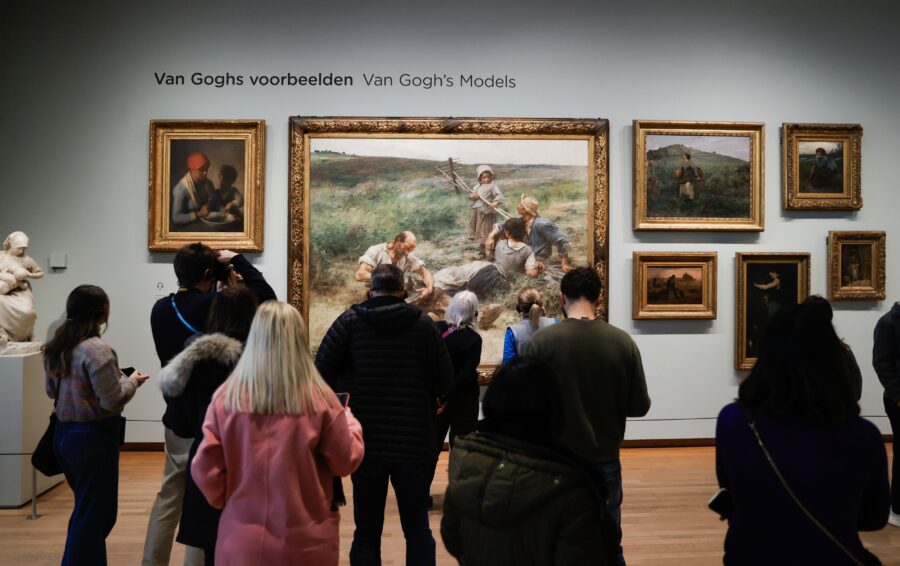
Amsterdam’s two big-ticket art museums sit just a stone’s throw from each other, but honestly, a smooth visit takes more than just showing up. Tickets sell out, crowds can get intense, and each place has its own quirks. If you prep a bit, you’ll spend your time soaking up masterpieces instead of standing in lines.
Museum Tickets and Booking Advice
Neither the Van Gogh Museum nor the Rijksmuseum lets you buy tickets at the door anymore. You have to book online ahead of time. For the Van Gogh Museum, those time slots can vanish days in advance, especially in peak summer.
Adult tickets hover around €22 for both, and under-18s get in free. The Van Gogh Museum offers student discounts, which is nice if you qualify.
If you’re thinking of squeezing both museums into one day, definitely leave a two-hour window between your bookings. That way, you’ve got time for lunch or a quick wander around Museumplein.
If you’re flying in just for a quick Amsterdam fix, I’d actually secure those museum tickets before even booking your flight. There’s nothing worse than landing and realizing your preferred day’s already sold out.
Best Times to Visit
Early mornings are golden. Show up right when they open and you’ll dodge the worst of the crowds, especially at the Van Gogh Museum, which fills up fast.
Weekdays usually feel calmer than weekends, and if you’re here in winter, you’ll find fewer tourists. Can’t do mornings? The last entry slot of the day is your next best bet.
The Rijksmuseum is bigger, so it swallows crowds better, but everyone still flocks to The Night Watch. I always head there first, then wander off into the quieter corners.
If your trip lasts a few days, maybe split your museum visits—no need to blitz through both and end up with art fatigue.
Duration and Accessibility
Most folks spend 1.5 to 2 hours at the Van Gogh Museum. The Rijksmuseum? You could lose half a day in there if you’re not careful, but you can see the highlights on a focused tour in a couple of hours.
Both museums are fully wheelchair accessible, and there are elevators if you need them. Audio guides come in several languages, and the Rijksmuseum even has an app with themed tours.
If you’re stacking up other activities—maybe a canal cruise—remember the walking times. The two museums are just a few minutes apart, so you can fit one in before or after a guided city tour without feeling rushed.
Lockers are free, but big bags aren’t allowed. Travel light and you’ll breeze through security and get right to the art.
Choosing the Right Museum for You
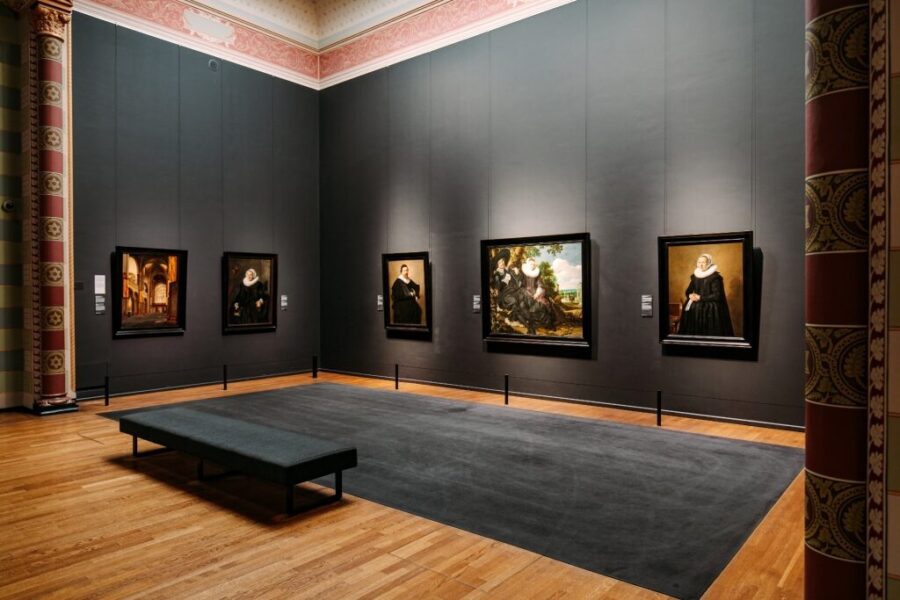
Amsterdam’s two headline art museums couldn’t be more different. One immerses you in a single artist’s world, while the other sweeps across centuries of Dutch culture. Your pick really depends on what you’re after—and how much energy you’ve got.
Ideal Audience for Each Museum
If you’re obsessed with Vincent van Gogh—his life, his wild brushwork, his struggles—then the Van Gogh Museum is your spot. It’s compact, so you can see all 200 paintings, plus sketches and letters, in about two hours. You’ll walk out genuinely understanding his evolution.
The Rijksmuseum is for those who want variety. Its galleries cover 800 years of Dutch art and history, from Rembrandt’s The Night Watch to ship models and Delftware. Give yourself at least three hours to do it justice.
Here’s a quick cheat sheet:
| If you… | Go to… |
|---|---|
| Love Van Gogh’s work | Van Gogh Museum |
| Want Dutch history + many artists | Rijksmuseum |
| Have limited time | Van Gogh Museum |
| Enjoy architecture as much as art | Rijksmuseum |
Combining Both Museums in One Day
You can absolutely do both in one day—they’re neighbors in Museumplein. I’ve done it myself and, trust me, you want to start early and book those tickets ahead. No more buying at the door.
I usually tackle the Rijksmuseum first thing in the morning. The collection is huge, and I’ve got more energy then. Afterward, I’ll grab a coffee or lunch nearby, then head to the Van Gogh Museum in the afternoon.
If you need a reset, hop on a canal cruise from the Rijksmuseum area. Some tours even toss in skip-the-line entry to both museums, which honestly saves time and stress.
Nearby Attractions and Museumplein
Museumplein isn’t just about these two museums. The Stedelijk Museum is right there, packed with modern and contemporary art—perfect if you want to switch gears. On sunny days, locals sprawl out on the grass, and there’s usually a laid-back, picnic vibe.
If you’re up for more, the Anne Frank House is about a 25-minute walk or a quick tram ride. It’s a heavier, more historical visit, but if you’ve got the time, I’d say don’t skip it.
You’ll also find plenty of cafés and quirky shops in the side streets. I like to wrap up my museum day with a late lunch at a corner café, just watching the city roll by before heading back to the center.
Frequently Asked Questions
Amsterdam’s two top museums really do offer totally different experiences. One dives deep into a single artist’s world, the other spans centuries of Dutch history and art. Knowing what each does best—and how to time your visit—makes all the difference.
What are the key differences in the collections of the Van Gogh Museum and the Rijksmuseum?
The Van Gogh Museum zooms in on Vincent van Gogh—his early sketches, iconic paintings like Sunflowers, and even his personal letters. You’ll get a sense of his inner world.
The Rijksmuseum, on the other hand, casts a wide net. It covers Dutch art from the Middle Ages to the 20th century, featuring Rembrandt, Vermeer, and loads more. You’ll also find sculpture, decorative arts, and historical artifacts.
Can you suggest which museum would be more suitable for a visitor with limited time in Amsterdam?
If you’re pressed for time and love Van Gogh, his museum is the obvious choice. It’s smaller, so you can see most of it in a couple of hours without feeling rushed.
If you want a broad Dutch art and culture fix, the Rijksmuseum is your spot—just focus on a few sections instead of trying to see everything.
Are there any combination tickets available that include entry to both the Van Gogh Museum and the Rijksmuseum?
Yep, you can find combo tickets and passes that cover both museums. Check official tourist sites, third-party sellers, or the I Amsterdam City Card.
They’ll save you a bit if you’re doing both, but always check the fine print—sometimes you still need to reserve separate time slots.
What unique experiences does each museum offer that can’t be found in the other?
The Van Gogh Museum gives you a personal, chronological walk through Van Gogh’s life and art. The way they tie his struggles to his changing style is honestly pretty moving.
The Rijksmuseum’s Gallery of Honour lines up masterpieces from the Dutch Golden Age in one dramatic hall. You’ll also find ship models and antique weapons—bits of Dutch history you won’t get at Van Gogh.
Could you highlight the best times to visit the Van Gogh Museum and the Rijksmuseum to avoid crowds?
For both, your best bet is right at opening or late in the afternoon. Weekdays beat weekends every time.
The Van Gogh Museum gets crowded quickly, so snagging the first slot of the day really helps. The Rijksmuseum’s size helps, but it still gets packed around midday.
What are the must-see exhibits for first-time visitors to both the Van Gogh Museum and the Rijksmuseum?
At the Van Gogh Museum, you really shouldn’t skip The Bedroom or those iconic Sunflowers. I always find myself lingering in front of his self-portraits, just trying to figure out what he was thinking.
If you’re even a little curious about Vincent’s life, check out the letters between him and his brother Theo. They add a personal touch you just can’t get from the paintings alone.
Over at the Rijksmuseum, Rembrandt’s The Night Watch draws the biggest crowds, and honestly, it’s worth weaving through them to see it up close.
But here’s a little tip—don’t rush past Vermeer’s The Milkmaid or those wild 17th-century dollhouses. The details in those miniatures are kind of mind-blowing, and they tell you so much about daily life back then. Sometimes, it’s the unexpected pieces that stick with you long after you leave.



